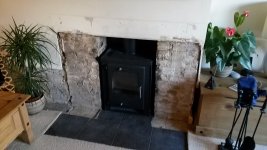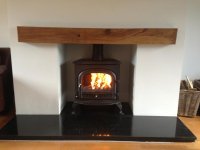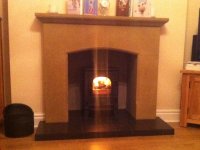Hi all
We are re-doing a fireplace in our house, and would like to go for a modern approach to it. We have already previously had a contemporary log burner installed into this recess not long ago at a fair cost, and do not wish to replace this or disturb its approved installation.
Basically the question is, what material should i use to line the inside of the fireplace? I am concerned that regular plasterboard will not be safe with the intense heat created by the burner?
In addition to this, i would like to paint the lining, but what paint is suitable for the heat generated here? Would standard emulsion stand up?
Obviously being a sealed burner there are no dust concerns as such, it is purely dry heat.
Image of current situation, noting the brick interior, which i wish to cover by slotting pre painted board down the sides. I will board and plaster the front wall, no problems with that. We already have an Oak beam (Old stone surround which we decided to get rid of) for the mantle from the old brick surround;

Image of desired end result (roughly speaking);

We are re-doing a fireplace in our house, and would like to go for a modern approach to it. We have already previously had a contemporary log burner installed into this recess not long ago at a fair cost, and do not wish to replace this or disturb its approved installation.
Basically the question is, what material should i use to line the inside of the fireplace? I am concerned that regular plasterboard will not be safe with the intense heat created by the burner?
In addition to this, i would like to paint the lining, but what paint is suitable for the heat generated here? Would standard emulsion stand up?
Obviously being a sealed burner there are no dust concerns as such, it is purely dry heat.
Image of current situation, noting the brick interior, which i wish to cover by slotting pre painted board down the sides. I will board and plaster the front wall, no problems with that. We already have an Oak beam (Old stone surround which we decided to get rid of) for the mantle from the old brick surround;

Image of desired end result (roughly speaking);

Last edited:



